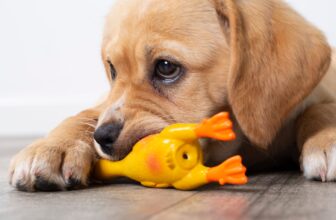
Are days of wagging tails and twice-daily trips to the dog park a thing of the past? As your furry friends begin to age, chances are they will experience changes to their physical and cognitive health like aching joints and mental confusion. However, by engaging in senior dog-friendly activities and introducing health regimens into their daily routine, you can help ease discomfort and prolong their life. That said, you’ll need to pay close attention to your dog’s specific needs, heed warning signs that they may be in pain, and consult with your vet before introducing new exercises and nutrients.
One vet-recommended way to help preserve your aging pup’s remaining energy is to engage in frequent, easy-going physical activity to keep their joints, bones, and muscles in tip-top shape for as long as possible. However, before heading out on your daily walk, consider the following ways you can help your dog remain active and comfortable long into its golden years.
Table of Contents
1. Consider joint health supplements for aching bones

img source: ctfassets.net
Regardless of your furry friend’s age, you should consider purchasing additional supplements to help them remain strong and agile well into their senior years. However, for aging pups, there are specific additives you’ll want to invest in to keep their joints pain and stress-free. But first, you’ll need to learn how to recognize signs of decline and discomfort.
Sure-fire signs your dog is experiencing joint and muscle pain are if they have trouble sitting or standing, excessively pant, favor one leg over the other, or experience swelling. Once you recognize the symptoms of aching bones, you can treat them accordingly by consulting with a vet or conducting independent research.
Consider investing in supplements high in fatty acids and chondroitin, which promote healthy joint and muscle function, or opt for a probiotic that combines various vitamins and nutrients into one handy product. Additionally, sites like these offer a quick guide to joint supplements for all those concerned dog parents looking to ease their furry friend’s aches and pains.
2. Try in low-impact exercises

img source: dogtime.com
Although it’s critical for your canine companion to remain active during their senior years, these senior-dog-friendly exercises can also be painful without the proper support. That said, you should prioritize activities like walking and swimming that are low-impact and easy on aching joints while still promoting good health.
However, when taking your senior dog on walks, try to keep them on a leash as often as possible to sidestep over-friendly interactions with other dogs that can result in injuries for your fragile pup.
Additionally, allow your dog to stop and sniff while out and about. Not only will this help your canine companion take much-needed breaks during the route, using their snout to smell various scents is an excellent source of entertainment and mental stimulation.
3. Change up their food

img source: chicagotribune.com
An unfortunate reality for many senior pups is inactivity due to excessive weight gain. While obesity can happen at any age, elderly dogs are prone to rapid increases as they begin to lose steam and experience daily aches and pains. A heavy stature in addition to normal age-induced discomfort can result in a complete standstill, as your dog refuses to get up and move around.
Thankfully, a simple swap to senior dog-friendly kibble may do the trick, potentially reverting excessive weight gain. While you may not be able to solve every daily discomfort, feeding your canine companion a well-balanced diet tailored to aging dogs can help regulate their weight and supply them with the proper nutrients.
Unlike puppy formulas that target high-energy, intense dogs by increasing fats and reducing carbohydrates, senior-dog-friendly recipes often include less protein and fat, added grains, and supplementary vitamins and oils for regulation. That way, geriatric dogs can remain alert and agile well into their golden years.
4. Introduce new toys and switch up activities

img source: purina.co.uk
Another way to keep your elderly pup up and active is by introducing new, exciting toys and activities into their life. Not only will they jump for joy at new fun-filled additions, but they will also reap the benefits of routine mental stimulation. Whether you land on an indestructible super-chewer Kong or a rope-spine stuffed animal, your furry friend will love their new playtoy.
Additionally, consider swapping out your daily walks—which can get monotonous for both you and your dog—and instead head out to your local pet shop or nature path to introduce new scents and sensations. By exploring different spots, each stroll will be unique and fresh in the mind of your pet, creating a world of fun for them each time you step out the door.
5. Visit the vet regularly

img source: sydneyvetspecialists.com.au
A critical aspect of caring for an aging dog is scheduling regular veterinary visits for an expert opinion regarding their health. By attending bi-annual meetings, you can keep up-to-date on vaccinations and medication, check in with the vet about any looming concerns, and rule out any irregularities. In addition, you can gain insight into vet-approved senior-friendly exercises and build a specialized plan tailored to your pet, ensuring their safety and comfort in their final years.
6. Don’t write off mental exercises

img source: germanshepherddoghq.com
An excellent route to take if you have a stubborn, exercise-resistant senior dog is to lay out mentally stimulating activities to promote cognitive health, an essential piece of their well-being puzzle. Not only will mental exercises excite them and incentivize movement, but they will also promote a sound mind and ward off dementia-like symptoms.
Try teaching your old dog new tricks, scattering their dinner for search-induced fun, or begin a game of hide-and-seek for anticipatory, prey-driven excitement. In addition, consider adding a prize element to their mind games by compensating them with a high-reward treat after they’ve performed each task. That way, they’ll jump at the opportunity to move around, coming back time and time again for a tasty snack.
Final thoughts
Helping your senior pup remain active doesn’t have to be a challenging task—if you understand how to encourage movement safely and comfortably. By feeding your aging dog a nutrient-rich, balanced diet, adding joint health supplements to reduce pain, and engaging in consistent physical and mental activity, your pup will remain healthy and happy until the bitter end.







